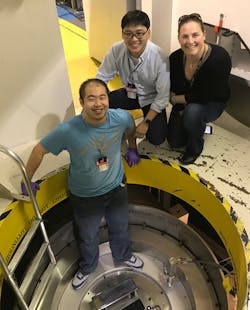Defects in Cathodes Could Improve Battery Performance
Engineers are in search of the perfect battery, one that will give smartphones longer-operating times, let electric vehicles drive for hundreds of miles on a single charge and let utilities and consumers store renewable energy for future use. One approach to the battery problem is by improving one of its components, the cathode.
To date, the typical way to improve cathodes has been to adjust their chemical composition. But now, chemists at the U.S. Department of Energy’s (DOE) Brookhaven National Laboratory have uncovered a new finding about battery performance that points to a different way to improve cathode materials.
“Instead of changing the chemical composition of the cathode, we can alter the arrangement of its atoms,” says Peter Khalifah, a research chemist at Brookhaven Lab and Stony Brook University.
Today, most cathode materials are comprised of alternating layers of lithium ions and transition metals, such as nickel. Within that layered structure there are usually a few defects. That means atoms from a transition metal can be found where a lithium ion is supposed to be and vice-versa.
“You can think of a defect as a ‘mistake’ in the perfection of the material’s structure,” Khalifah explains. “It is known that a lot of defects lead to poor battery performance, but what we’ve come to find out is that a small number of defects should improve key properties.”
Khalifah says there are two properties good cathode materials have: ionic conductivity (the lithium ions can move well) and electronic conductivity (the electrons also move well).
“A defect is like a hole poked between the lithium and transition metal layers in the cathode,” he says. “Instead of being confined to two dimensions, the lithium ions and electrons can then move in three dimensions across the layers.”
To prove this theory, Brookhaven scientists needed to precisely measure the concentration of defects in a cathode material and see how it performed.
“The concentration of defects in a cathode material varies between two and five percent,” Khalifah explains. “Prior to our work, defects could only be measured with a sensitivity of about one percent. In our work, we measured defect concentration with a sensitivity of a tenth of a percent.”
To get this precision, the scientists conducted powder diffraction analyses using data from two major DOE resources, the Advanced Photon Source (APS) at Argonne National Laboratory and the Spallation Neutron Source (SNS)at Oak Ridge National Laboratory.
Powder diffraction reveals where individual atoms are within a material by directing beams of x-rays, neutrons or electrons at the material level and studying how the beams diffract. In this project, the team conducted x-ray measurements at the APS and neutron measurements at SNS.
“This work developed a new way of visualizing structural defects and their relationship to diffraction and scattering strength,” says Saul Lapidus, a physicist at APS. “This technique will likely be used commonly in the battery community to understand defects and structural characterizations of cathode materials.”
Khalifah added, “the ability to measure the concentration of weakly scattering elements with the sensitivity of a tenth of a percent will also be useful for many other areas of research, such as measuring oxygen vacancies in superconducting materials and catalysts.”
With such accurate measurements of defect concentrations, the scientists could then examine the relationship between defects and cathode material chemistry.
Ultimately, they developed a “recipe” for achieving any defect concentration which, in the future, could guide scientists to build cathodes from more affordable and environmentally friendly materials and then tune their defect concentrations to get the best battery performance.

